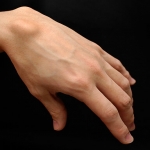What’s That Lump?

Did you wake up with an odd lump on your wrist out of the blue? Did it double in size with in just a couple of days? You might have referred to Dr. Google for a quick diagnosis, and after weeding through every possible bump under the sun, you stumbled across a picture that looks just like your bump, a ganglion cyst!
Ganglion cysts typically develop along the tendons or joints of your wrist of hands. They can also occur around the elbows, knees, feet, and ankles!
Ganglion cysts are typically round or oval, and are filled with a gelatinous fluid. These cysts are no cause for concern, though they can become painful and can sometimes interfere with joint movement. Even though these cysts are quite common, no one knows exactly what causes them to develop.

Let’s break down some ways to determine if this is indeed a ganglion cyst:
- Try pointing a flashlight at your bump! If a light can shine through it, it is likely you have a ganglion cyst. This experiment proves that it’s not a solid mass, but a mass filled with liquid.
- Push around on it! The area should be somewhat flexible but may still feel firm. In other words, you should be able to push around on it a bit.
Treatments are easy and relatively pain free. A few generations ago, treatment was whacking the bump with a big, thick book. A little ‘whacky’ if you ask us! However, during that time they said if you banged it hard enough it might TEMPORARILY go down. This is an unpredictable option that may cause other damage, and usually doesn’t work long term. We would also encourage you to NOT POKE at the cysts with a sewing needle, kitchen knife, or other sharp blade as this can lead to a pretty nasty infection.

One option is an aspiration, which is a quick way to get the fluid pulled out of the mass. This is done in the office, where the physician sticks a needle into the cyst and drains out the fluid. Cortisone is sometimes injected into the area to help reduce the chances of the mass returning.
If the cyst returns, surgery to remove the mass is another option. Click the link to see what to expect if you visit with Dr. Walker for surgery!
The surgeon will remove the cyst and the stalk that attaches it to the tendon or joint. There is a risk of the ganglion returning with any of the treatment options. Sometimes if a ganglion is there but not bothersome, the best option is to just keep an eye on it.
Written by: Marisa Bradford, NRCMA

